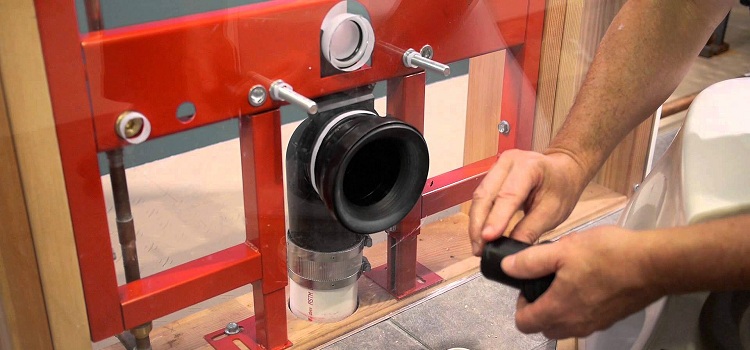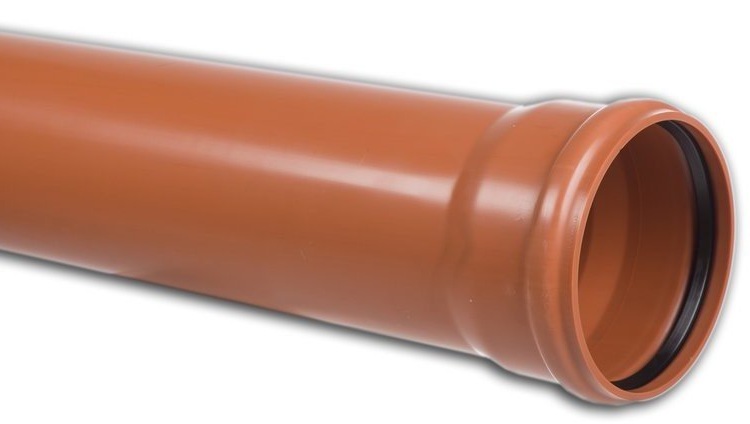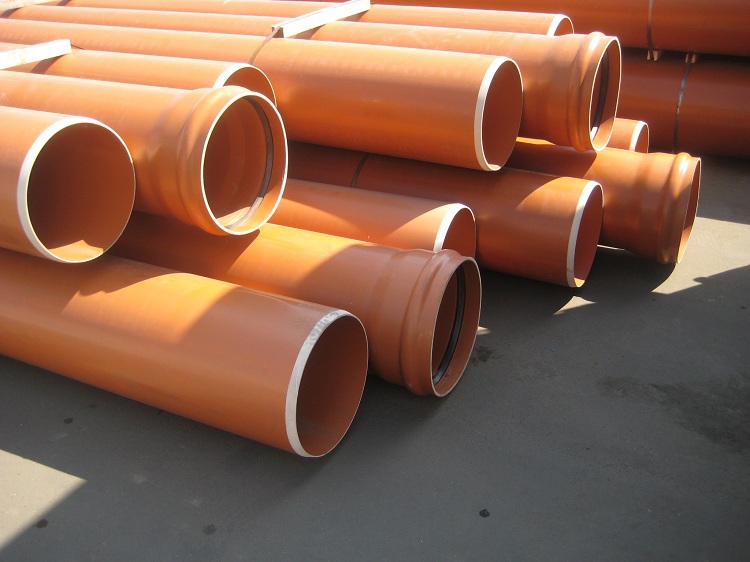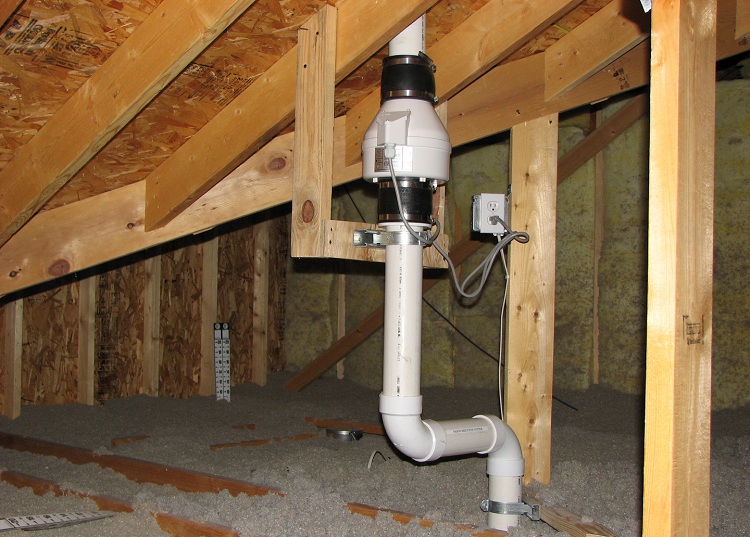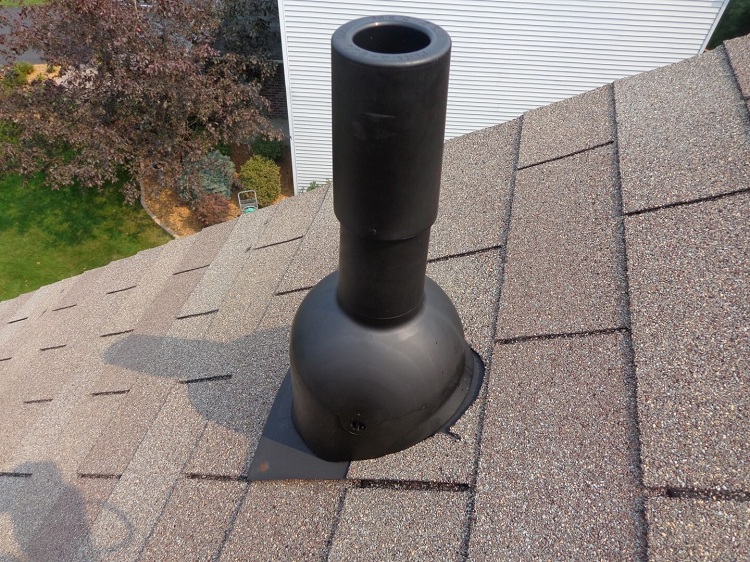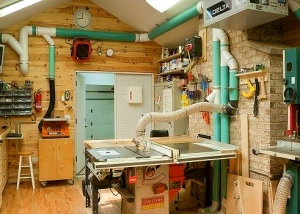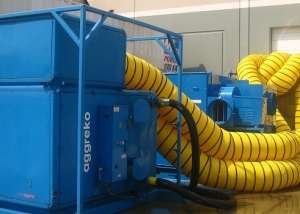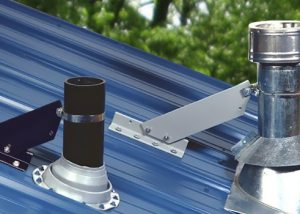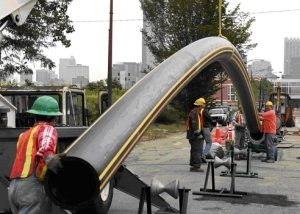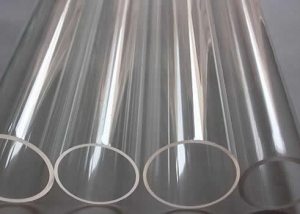A sewer sewer pipe is a part of the pipeline system that ensures the joining of a sewer riser (draining sewage from sanitary equipment) and the atmosphere. A sewer pipe performs a barrier function: if it exists, gases that accumulate in the drainage network do not leak into the living room. In addition, it performs a soundproofing function. Such a product is presented on the market in the form of cast-iron, copper or plastic (PVC) blanks. The most popular option is the use of plastic products.
Content
What are fan pipes for?
In accordance with building codes, the installation of fan pipes is necessary in most cases. This is due to the fact that the gases that accumulate in the sewer system are looking for a way out and without a protective barrier they penetrate the apartment and create not only discomfort, but also a danger to residents. Thanks to the watertight elements, this does not happen.
The fan pipe with an offset for the toilet looks like a curved siphon. It is filled with water to a certain level and this allows you to cope with a sufficiently large back pressure in the system. In cases where the installation of the fan pipe was carried out incorrectly or the riser was broken, the water-tight shutter parts fail, and the gases gain access to the room. Therefore, it is very important to install this equipment in accordance with all the rules.
In addition, the penetration of sewage gases into the apartment is possible in case of damage or disruption of the water lock. Disruption of the water trap occurs as a result of the closure of the entire diameter of the riser by sewage fluid. This is a fairly common problem. The accumulation of deposits on the walls of the siphon contributes to an emergency. All of this can be avoided thanks to a fan boner. Basically, it exits through the roof. The principle of operation is that when a vacuum appears in the system, air is delivered through the fan pipe for the toilet, which normalizes the pressure level in the system.
Important! If an installed valve is involved in the operation of a fan device, then it is possible to avoid putting the system on the roof of the house, which is a very convenient solution in some cases.
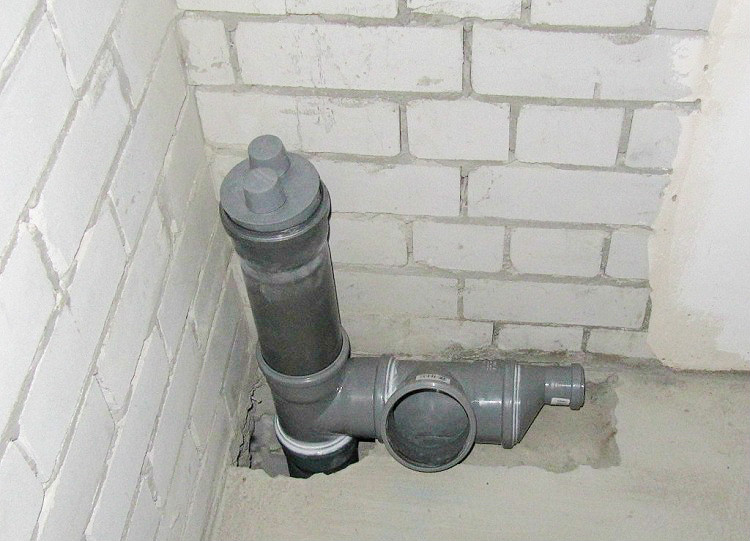
The fan riser is mounted during the installation of the sewage system, it must be included in the system design during the construction of the building
Materials from which fan pipes for sewage are made
A fan item usually includes:
- tee;
- safety valve with cover;
- several pipes.
A fan pipe for a toilet is divided into types according to the material from which it is made. The most common materials are cast iron and polyvinyl chloride, and risers made of copper material are also found. PVC is the most popular of these two options due to the fact that it has several advantages over metal counterparts. It has resistance to corrosion and almost no deposits are deposited on its walls.In addition, the low cost and ease of installation makes PVC products the leader in the market of fan pipes.
However, metal elements are not completely superseded by PVC products and in many private homes you can find parts made of cast iron or copper alloy.
Depending on whether there is a protective valve in the fan riser, the devices are divided into two more types. As already mentioned above, the safety valve prevents wastewater from reaching the surface. Such a part has a lid or petals. When washing off wastewater, the valve opens and promotes its withdrawal, and then closes, preventing its movement towards the premises. Thus, we can say that the valve regulates the direction of movement of water and prevents its movement in the opposite direction. It also performs a barrier function and prevents debris from entering the system, thereby reducing the likelihood of clogging of the sewer. In addition, the sewer sewer pipe varies in size.
Sizes of fan pipes
The length of the pipe can be completely different. An important parameter, which in any case must be taken into account when choosing and installing the product, is the diameter of the fan pipe.
The diameter of the fan pipe for the toilet is recommended to choose 40 mm more than the diameter of the drain. Standard diameters for drain pipes are 50 and 70 mm. For such sizes, fan articles with diameters of 90 and 110 mm are ideal. If desired, you can choose a part of even larger sizes, but this does not make much sense.
The choice of such diameter indicators is due to the fact that the sewage substrate can create strong pressure and interfere with the normal operation of the structure. In this case, the wider the walls, the less chance that a powerful stream can disable the system. The cross-sectional size of parts of the internal sewage system is smaller than the diameter of the fan pipe, and the external pipe is larger because sewage from several risers is discharged through them and higher pressure is created in them. The difference in size assigned the name “adapter” to the fan item.
Installation of fan pipes is mandatory if:
- the number of storeys of the house exceeds 1 floor and there is a bathroom in the building;
- the design is presented on the 1st floor and includes 2 or more bathrooms;
- the house has 2 or more risers with a small diameter (50 mm);
- the presence of a jacuzzi or pool;
- the drain pit is too close to the residential building (8–10 m and closer).
Note! It is very important to remember that regardless of the type and characteristics of the sewer system (such systems can be self-flowing or forced), the installation of a fan pipe is necessary when the slope of the sewer is incorrect. Insufficient slope can cause malfunction of the sewer system and various accidents.
The fan design, among other things, performs a soundproofing function. Thanks to her work, people living in the house do not hear the sounds of wastewater movement. This function is very important, because noise, especially in plastic pipes, is sometimes very annoying
Views by installation type
Depending on the type of installation, all fan sewage pipes are divided into: straight, angular, vertical.
Straight. Such a sewer pipe is perpendicular to the toilet. As a rule, this type is used when installing sewage in high-rise buildings.
Corner They are used in non-standard cases. Also, the planning of such a design can be carried out for the sewerage branching.
Vertical. As a rule, they are mounted in two-story buildings, which include two or more bathrooms.They contribute to the elimination of rarefaction, due to which water disappears in the siphons of sinks and toilets, and unwanted sewage accumulates.
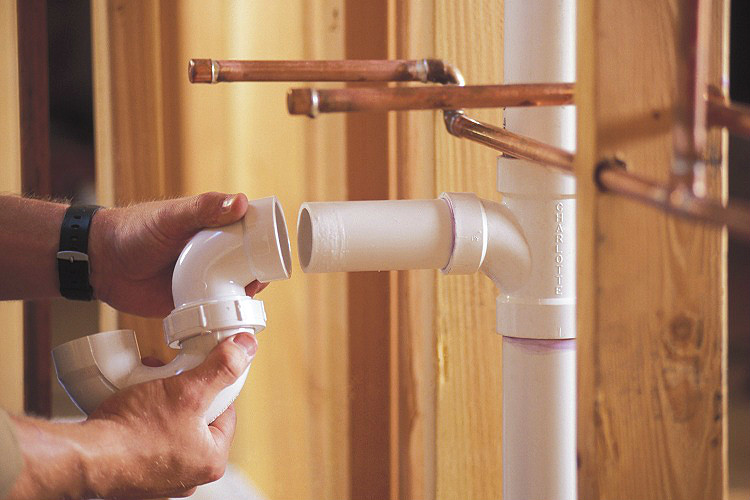
The vertical arrangement of the fan pipe is suitable for houses in which the number of bathrooms is more than one
Fan designs constantly maintain a certain level of water in siphons. When water disappears, the path for gases opens, and they fill the premises. And elements that do not have a sewage outlet are simply clogged, which contributes to the failure of the entire sewer line.
Mounting Features
When installing fan pipes, several key points must be taken into account:
1. The fan pipe with a diameter should be more drain. It is best to cope with your task with a 110 mm section. The diameter of the fan pipes for the toilet is a very important parameter that affects the entire design.
2. It is recommended that the pipes be placed in a position that will allow the most efficient removal of gases. For apartments, the optimal placement is perpendicular to the toilet.
3. The beginning of the sewer system must be installed in a room that is heated. The end point is located in a cold room. Due to this, the required temperature difference provides the desired pressure in the network.
Important! A sewer pipe can be made independently from any sewer pipe, since it is a continuation of the sewer riser.
Sewer gases appear due to the fact that insufficient volume devices are mounted on plumbing fixtures. The siphon must have sufficient capacity, then the water in it will not dry out quickly and the path for unpleasant odors will not open.
Fan vent pipe outlet
A ventilation system is necessary for the normal functioning of the sewage system, which carries out the transportation of wastewater into external pipes.
To carry out the correct installation of the fan pipe and ventilation, you need to remember several important rules:
- The combination of the output of the riser with ventilation or a chimney is strictly prohibited.
- The pipe outlet is located above the roof and is installed at a height of 4 m at a safe distance from the windows of balconies, etc.
- One such design can combine several risers. In this form of connection, straight knees and straight tees or oblique knees with tees of 45 degrees are used.
Need to know! It is forbidden to carry out ventilation ventilation under a roof canopy. This is due to the fact that in winter, snow falling from the roof can damage it.
The roof stand is a self-contained device and does not need to mount additional devices that carry out the hood (for example, a deflector). In addition, the installation of additional devices can harm the functioning of the system as a whole, violating the established indicators of traction and pressure.
Valve installation
As a rule, check valves are installed on fan pipes. This is especially important when the sewer slope is inaccurate. Check valves protect the system from:
- changes in the direction of wastewater flow;
- rodents;
- contamination of the system with impurities.
Installation of such a valve can be carried out on the inner or outer wall of the structure. When mounting the valve on the inner wall, all necessary manipulations to clean it should be done: clean from plaque and degrease. The non-return valve is located in the direction of the flow of wastewater, and its cover (or petals) opens towards the location of the plumbing fixture. When installing a fan device, the diameter of which is 110 mm, a special device — an adapter — will be needed to install such a valve. If a bell is cut on a pipe made of strong gray cast iron, the valve is installed directly in it.
In general, it is important to remember that the bias of fan pipes is a very important parameter that should not be neglected.
Important! When installing a check valve, the use of silicone-based lubricants is strictly prohibited. All installation steps must be carried out in dry conditions.
If the system does not comply with the slope, and fan pipes cannot be installed, the installation of the valve partially solves the problem. This will help to cope with the penetration of gases into residential premises, but no more. Installation of the valve is a simpler measure, because for it there is no need to produce ventilation on the roof of the house. The service life of the check valve ranges from 5 to 7 years. The movable elements included in its design are a weak point and often the valve needs to be replaced.
With the right choice of fan pipe and a valve to it, your home will be protected from unpleasant odors, clogging of plumbing and the noise of sewage that travels along the sewer line. The choice of this device should be approached with all seriousness. Their assortment is large enough to choose the size of fan pipes that are suitable for your specific case. When purchasing such an important device, it is recommended to consult with a specialist in order to choose a product that meets all the requirements.
